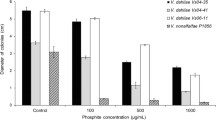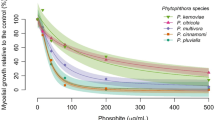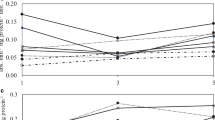Abstract
Phosphites have low-toxicity on the environment and show high efficacy in controlling oomycete diseases in plants, both by a direct and an indirect mechanism. We have shown that they are also effective in reducing disease symptoms produced by Phytophthora infestans, Fusarium solani and Rhizoctonia solani when applied to potato seed tubers. To gain better insight into the direct mode of action of phosphites on different potato pathogens, and to ascertain chemical determinants in their direct antimicrobial activity, four potato pathogens were assayed with respect to sensitivity toward calcium, potassium and copper phosphites (CaPhi, KPhi and CuPhi, respectively). The influence of acidification and ionic strength changes after Phi addition on the antimicrobial activity, and the fungicidal or fungistatic activity, were evaluated. Results showed that phosphites were able to inhibit growth of all pathogens. Phytophthora infestans was the most inhibited pathogen by all phosphites, followed by Streptomyces scabies, while Rhizoctonia solani and Fusarium solani were less inhibited. CuPhi had the highest antimicrobial activity against the four pathogens analysed, and CaPhi and KPhi showed similar antimicrobial activities. Inhibitions by CuPhi and CaPhi could be partially explained by acidification of the media. However, results obtained with KPhi demonstrated that the phosphite anion has antimicrobial activity itself. The increase in ionic strength after Phi addition was not important in the antimicrobial activity of Phi. The activity of phosphites on germination of F. solani spores showed to be fungistatic rather than fungicidal.
Zusammenfassung
Phosphite besitzen eine geringe Umwelttoxizität sowie eine gute direkte und indirekte Wirkung gegenüber Oomyceten- Pathogenen von Pflanzen. Wir zeigen hier, dass sie ebenfalls die durch Phytophthora infestans, Fusarium solani and Rhizoctonia solani verursachten Symptome an Kartoffeln nach einer Knollenbehandlung vermindern. Vier Kartoffelpathogene wurden mit dem Ziel untersucht, die direkte Wirkungsweise von Calcium-, Kalium- und Kupfer-Phosphiten (CaPhi, KPhi und CuPhi) auf die Erreger sowie die chemischen Determinanten ihrer direkten antimikrobiellen Aktivität zu ermitteln. Weiterhin wurde die Wirkung von Azidifizierung und Ionenstärke nach Zugabe von Phosphiten auf antimikrobielle, fungizide und fungistatische Aktivität untersucht. Die Phosphite beeinträchtigten das Wachstum aller untersuchten Erreger. Phytophthora infestans wurde durch alle verwendeten Phosphite am stärksten inhibiert, gefolgt von Streptomyces scabies, während die Wirkung auf Rhizoctonia solani und Fusarium solani geringer war. CuPhi besaß die höchste antimikrobielle Aktivität gegenüber den vier untersuchten Pathogene, gefolgt von den ähnlich wirksamen CaPhi und KPhi. Die Wirkung von CuPhi und CaPhi kann zum Teil durch die Ansäuerung der verwendeten Medien erklärt werden. Die mit KPhi erhaltenen Ergebnisse zeigen dagegen, dass das Phosphit-Anion selbst antimikrobiell wirksam ist. Die Zunahme der Ionenstärke nach Phosphit-Applikation war nicht für die antimikrobielle Wirkung verantwortlich. Die Beeinträchtigung der Sporenkeimung von F. solani zeigte, dass die Wirkung der Phosphite eher fungistatisch als fungizid ist.
Similar content being viewed by others
References
Andreu, A.B., M.G. Guevara, E.A. Wolski, G.R. Daleo, D.O. Caldiz, 2006: Enhancement of natural disease resistance in potatoes by chemicals. Pest Manag. Sci. 62, 162–170.
Avis, T.J., M. Michaud, R.J. Tweddell, 2007: Role of lipid composition and lipid peroxidation in the sensitivity of fungal plant pathogens to aluminum chloride and sodium metabisulfite. Appl. Environ. Microbiol. 73, 2820–2824.
Bashan, B., Y. Levy, Y. Cohen, 1990: Variation in sensitivity of Phytophthora infestans to fosetyl-Al. Plant Pathol. 39, 134–140.
Bécot, S., E. Pajot, D. Le Corre, C. Monot, D. Silué, 2000: Phytogard® (K2HPO3) induces localized resistance in cauliflower to downy mildew of crucifers. Crop Prot. 19, 417–425.
Brown, S., S.T. Koike, O.E. Ochoa, F. Laemmlen, R.W. Michelmore, 2004: Insensitivity to the fungicide fosetyl-aluminum in California isolates of the lettuce downy mildew pathogen, Bremia lactucae. Plant Dis. 88, 502–508.
Caten, C.E., J.L. Jinks, 1968: Spontaneous variability of single isolates of Phytophthora infestans. I. Cultural variation. Can. J. Bot. 46, 329–348.
Cohen, Y., M.D. Coffey, 1986: Systemic fungicides and the control of oomycetes. Annu. Rev. Phytopathol. 24, 311–338.
Cooke, L.R., G. Little, 2002: The effect of foliar application of phosphonate formulations on the susceptibility of potato tubers to late blight. Pest Manag. Sci. 58, 17–25.
Fenn, M.E., M.D. Coffey, 1984: Studies on the in vitro and in vivo antifungal activity of fosetyl-Al and phosphorous acid. Phytopathology 74, 606–611.
Garbelotto, M., T.Y. Harnik, D.J. Schmidt, 2009: Efficacy of phosphonic acid, metalaxyl-M and copper hydroxide against Phytophthora ramorum in vitro and in planta. Plant Pathol. 58, 111–119.
Guest, D., B. Grant, 1991: The complex action of phosphonates as antifungal agents. Biol. Rev. 66, 159–187.
Guest, D.I., G. Bompeix, 1990: The complex mode of action of phosphonates. Australas. Plant Pathol. 19, 113–115.
Johnson, D.A., D.A. Inglis, J.S. Miller, 2004: Control of potato tuber rots caused by Oomycetes with foliar applications of phosphorous acid. Plant Dis. 88, 1153–1159.
Lobato, M.C., F.P. Olivieri, E.A. González Altamiranda, E.A. Wolski, G.R. Daleo, D.O. Caldiz, A.B. Andreu, 2008a: Phosphite compounds reduce disease severity in potato seed tubers and foliage. Eur. J. Plant Pathol. 122, 349–358.
Lobato, M.C., M. Machinandiarena, M.L. Feldman, G.R. Daleo, F.P. Olivieri, A.B. Andreu, 2008b: Efecto de la aplicación de fosfitos sobre la resistencia a enfermedades del cultivo de papa. Estudio de los mecanismos bioquímicos involucrados. XXIII Congreso de la Asociación Latinoamericana de papa, Mar del Plata, Argentina, 30 November–6 December 2008, 331–332.
McDonald, A.E., B.R. Grant, W.C. Plaxton, 2001: Phosphite (phosphorous acid): its relevance in the environment and agriculture and influence on plant phosphate starvation response. J. Plant Nutr. 24, 1505–1519.
Mendieta, J.R., M.R. Pagano, F.F. Muñoz, G.R. Daleo, M.G. Guevara, 2006: Antimicrobial activity of potato aspartic proteases (StAPs) involves membrane permeabilization. Microbiology 152, 2039–2047.
Mills, A.A.S., H.W. Platt, R.A.R. Hurta, 2004: Effect of salt compounds on mycelial growth, sporulation and spore germination of various potato pathogens. Postharvest Biol. Technol. 34, 341–350.
Niere, J.O., G. Deangelis, B.R. Grant, 1994: The effect of phosphonate on the acid-soluble phosphorus components in the genus Phytophthora. Microbiology 140, 1661–1670.
Ouimette, D.G., M.D. Coffey, 1989: Phosphonate levels in avocado (Persea americana) seedlings and soil following treatment with fosetyl-Al or potassium phosphonate. Plant Dis. 73, 212–215.
Panicker, S., K. Gangadharan, 1999: Controlling downy mildew of maize caused by Peronosclerospora sorghi by foliar spays of phosphonic acid compounds. Crop Prot. 18, 115–118.
Reuveni, M., D. Sheglov, Y. Cohen, 2003: Control of moldy-core decay in apple fruits by ß-aminobutyric acids and potassium phosphites. Plant Dis. 87, 933–936.
Stehmann, C., B.R. Grant, 2000: Inhibition of enzymes of the glycolytic pathway and hexose monophosphate bypass by phosphonate. Pestic. Biochem. Physiol. 67, 13–24.
Vawdrey, L.L., D. Westerhuis, 2007: Field and glasshouse evaluations of metalaxyl, potassium phosphonate, acibenzolar and tea tree oil in managing Phytophthora root rot of papaya in far northern Queensland, Australia. Australas. Plant Pathol. 36, 270–276.
Wilkinson, C.J., B.L. Shearer, T.J. Jackson, G.E.S.J. Hardy, 2001: Variation in sensitivity of Western Australian isolates of Phytophthora cinnamomi to phosphite in vitro. Plant Pathol. 50, 83–89.
Zar, J.H., 1999: Biostatistical Analysis. Prentice-Hall, Upper Saddle River, NJ, USA.
Author information
Authors and Affiliations
Corresponding author
Rights and permissions
About this article
Cite this article
Lobato, M.C., Olivieri, F.P., Daleo, G.R. et al. Antimicrobial activity of phosphites against different potato pathogens. J Plant Dis Prot 117, 102–109 (2010). https://doi.org/10.1007/BF03356343
Received:
Accepted:
Published:
Issue Date:
DOI: https://doi.org/10.1007/BF03356343
Key words
- disease control
- Fusarium solani
- growth inhibition
- Phytophthora infestans
- Rhizoctonia solani
- Streptomyces scabies




